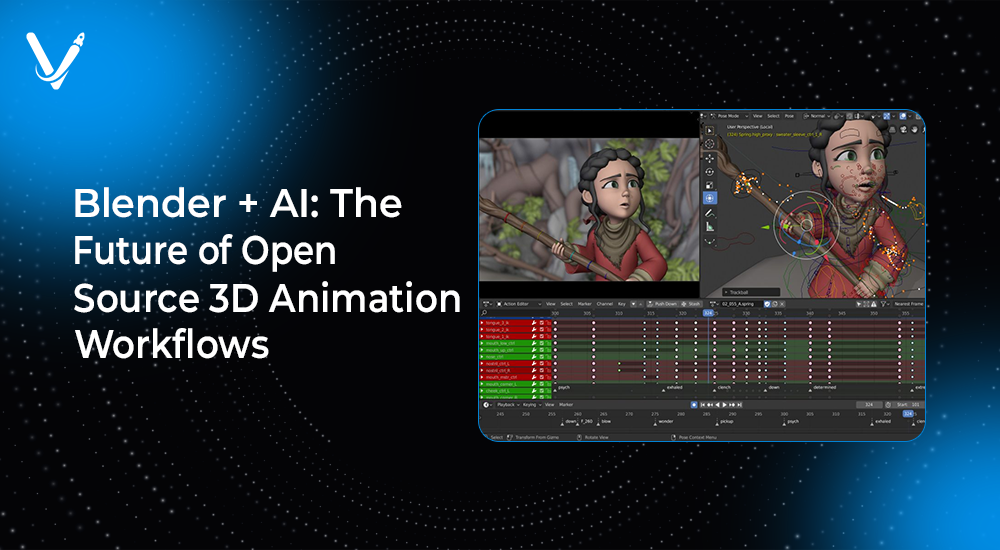Blender + AI: The Future of Open Source 3D Animation Workflows


- Oct 3, 2025



The world of 3D animation has always been a balance between artistry and technology. On one side, creative vision drives storytelling, character design, and environments that bring digital worlds to life. On the other hand, powerful tools and workflows ensure that ideas can be translated into polished animations without overwhelming artists with repetitive tasks. Blender, the most popular open-source 3D creation suite, has already transformed the landscape by giving independent creators, small studios, and even large enterprises access to professional-grade tools free of licensing costs. But today, a new force is reshaping how 3D animation is produced—Artificial Intelligence.
The intersection of Blender and AI represents more than just an incremental upgrade to workflows. It signals a future where AI models can accelerate animation pipelines, automate tedious processes, generate assets on demand, and even enhance creativity itself. Just as Blender disrupted the traditional dominance of expensive 3D software, the infusion of AI could democratize animation even further, enabling anyone to create at a professional level with unprecedented efficiency.
This article dives deep into the emerging relationship between Blender and AI. We’ll explore how AI is integrated into Blender workflows, its impact on modeling, texturing, rigging, and rendering, as well as real-world use cases. We’ll also consider challenges, ethical debates, and the long-term future of AI-driven open-source animation. By the end, you’ll have a comprehensive understanding of why Blender combined with AI is positioned to define the future of 3D animation.
Blender is not just another software; it’s a movement. Over the past two decades, it has grown from a niche project into a powerhouse used by millions worldwide. With features for modeling, sculpting, animation, rigging, rendering, and video editing, Blender offers a holistic platform that competes with industry titans like Maya, 3ds Max, and Cinema 4D. What makes Blender unique is its open-source nature. This has created a vibrant global community of contributors constantly improving the platform.
The open-source model has significant implications for AI integration. Unlike proprietary software, Blender allows developers to freely experiment, build plugins, and integrate cutting-edge AI models. This openness fosters a culture of rapid innovation where AI experiments can move from research papers to practical workflows far faster than in closed ecosystems. In short, Blender’s DNA of openness makes it the perfect foundation for AI-powered 3D animation.
AI has already begun transforming creative industries in profound ways. Text-to-image models like Stable Diffusion, MidJourney, and DALL·E have shown that machines can generate compelling visuals with minimal human input. Audio models can compose music, while natural language models generate scripts and dialogues. In animation, AI is increasingly used to automate tasks such as motion capture cleanup, lip-syncing, and physics simulations.
The integration of AI into Blender is a natural evolution of this trend. Imagine typing a text prompt to generate a 3D character base mesh, or asking an AI assistant to automatically rig a model with realistic bones and skin weights. These aren’t distant possibilities; they are already being prototyped by developers and researchers. As AI continues to advance, its influence on Blender workflows will only grow stronger.
One of the most time-consuming parts of 3D animation is asset creation. Building detailed characters, environments, and props often takes weeks or months. AI models trained on large 3D datasets are changing this dynamic by enabling generative asset creation.
Tools already exist that can generate 3D meshes directly from text prompts or 2D images. By integrating such capabilities into Blender, artists could rapidly prototype characters or environments before refining them manually. This workflow significantly reduces production time while still leaving room for artistic control.
For example, an animator working on a sci-fi film might need hundreds of unique spaceship designs. Instead of modeling each one from scratch, AI-powered Blender plugins could generate dozens of variations instantly, allowing the artist to choose, refine, and customize the best designs. This accelerates iteration and unlocks new levels of creativity.
Texturing is another area where AI is making a profound impact. Creating realistic textures traditionally involves photographing real-world materials, using texture painting tools, or sourcing assets from online libraries. AI models can now generate seamless, high-resolution textures in seconds.
By linking Blender to AI-driven texture generators, artists can instantly create procedural materials that adapt to lighting conditions and surface geometry. Imagine typing “rusty metal plate with peeling paint” into a Blender panel and instantly receiving a usable, tileable material. AI also assists in upscaling, cleaning, or transferring texture styles, making asset libraries richer and more versatile.
Rigging—building skeletons and controls for 3D characters—has long been one of the most technically demanding parts of animation. AI has the potential to drastically simplify this. Deep learning models trained on motion capture data can predict natural joint placements, automate skin weight painting, and even generate realistic animations without manual keyframing.
Motion synthesis powered by AI allows animators to blend different styles or generate entirely new motions. For example, training a model on dance performances can enable an AI-powered Blender plugin to generate dance sequences for characters instantly. This doesn’t eliminate animators; it empowers them to focus on higher-level creative choices like choreography and emotion, while leaving technical details to automation.
Rendering is notoriously resource-intensive, often requiring large farms of GPUs or CPUs. AI-based denoising and super-resolution techniques are already reducing rendering times in Blender’s Cycles and Eevee engines. AI can also help optimize light bounces, predict final frames, and interpolate missing data, drastically reducing production costs.
In post-production, AI offers tools like rotoscoping, color correction, and video enhancement. Blender already integrates machine learning add-ons for tasks like AI upscaling or real-time object tracking. As these capabilities expand, post-production becomes faster and more accessible for small studios and independent creators.
The integration of Blender and AI is no longer theoretical; it’s happening across industries. Independent game developers use AI-assisted Blender workflows to generate 3D assets quickly. Architecture firms combine AI rendering with Blender’s modeling to produce photorealistic visualizations in record time. Educators leverage AI-driven Blender plugins to teach students faster by removing technical barriers. Even large animation studios experiment with AI for pre-visualization, crowd simulation, and motion generation.
These examples prove that Blender and AI together aren’t just tools—they’re enablers of entirely new creative workflows.
Despite its promise, AI integration in Blender faces challenges. Training data quality is critical, and poor datasets can lead to inaccurate or biased outputs. Intellectual property concerns also arise when AI models generate assets based on copyrighted material. Ethical debates about AI replacing human creativity are ongoing, though the consensus increasingly views AI as an assistant rather than a replacement.
Technical hurdles also exist. Running large AI models inside Blender requires significant GPU resources. Cloud-based integrations may solve this, but they raise questions about privacy and accessibility. For Blender’s open-source ethos, ensuring that AI tools remain transparent and widely available will be crucial.
Looking ahead, the combination of Blender and AI could redefine open-source 3D animation. Imagine fully integrated AI assistants that guide artists throughout the pipeline, from concept art to final renders. Picture collaborative platforms where AI-generated assets are shared, remixed, and improved by global communities.
As AI evolves, Blender could serve as the ultimate open playground for experimentation in 3D animation. Unlike closed platforms tied to corporate agendas, Blender ensures that these innovations remain accessible to all. The result is not just faster workflows, but a democratization of animation that empowers individuals and small teams to produce content previously achievable only by large studios.
For individual creators, Blender plus AI opens doors to faster prototyping, reduced costs, and higher-quality results. For enterprises, it represents a way to streamline pipelines, reduce overhead, and scale content production. The synergy between Blender’s open-source foundation and AI’s automation power creates a unique ecosystem where creativity and efficiency coexist.
Enterprises looking to innovate in areas like gaming, film, advertising, or virtual reality will find Blender plus AI especially attractive. It lowers barriers to entry, fosters experimentation, and offers flexible, future-proof workflows.
Blender and AI together represent one of the most exciting frontiers in digital creativity. By combining open-source innovation with the intelligence of machine learning, this partnership is redefining what’s possible in 3D animation. From asset generation and rigging to rendering and post-production, AI-driven workflows within Blender are accelerating production, empowering artists, and democratizing access to professional-grade animation.
The future of open-source 3D animation isn’t just about better tools—it’s about smarter workflows that amplify human creativity. At Vasundhara Infotech, we believe this transformation will shape the next era of digital storytelling. If your organization wants to explore AI-powered animation pipelines, our team is ready to help you embrace the future of Blender and AI. Let’s collaborate to build smarter, faster, and more innovative animation experiences.
What are the main benefits of Blender + AI?
Key benefits include faster workflows, reduced costs, enhanced realism, and democratized access to professional animation tools.
Copyright © 2025 Vasundhara Infotech. All Rights Reserved.